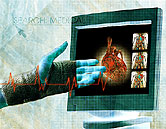 |
 |
 |

Survival Rate Little Changed With Aortic Valve Disorder
Young adults with the common congenital heart defect don't have worse outcomes, study says|
|
HealthDay
By Robert Preidt
Tuesday, September 16, 2008
 TUESDAY, Sept. 16 (HealthDay News) -- Young adults with a congenital heart defect called a bicuspid aortic valve don't have lower survival rates than those in the general population, say Canadian researchers.
TUESDAY, Sept. 16 (HealthDay News) -- Young adults with a congenital heart defect called a bicuspid aortic valve don't have lower survival rates than those in the general population, say Canadian researchers.
A bicuspid aortic valve has only two flaps (cusps) that open and close, instead of the normal three. It's the most common congenital heart defect in the adult population. Prior studies have reported significant death and illness associated with the defect.
The researchers examined cardiac outcomes and disease progression in 642 patients, average age 35. Over an average period of nine years, 161 of the patients (25 percent) in this study had one or more primary cardiac events: cardiac-related death, 17 patients; intervention on the aortic valve or ascending aorta (first section of the aorta), 142 patients; aortic tearing or aneurysm, 11 patients; or congestive heart failure requiring hospitalization, 16 patients.
Independent predictors of primary cardiac events included: being older than age 30; moderate or severe aortic narrowing; and moderate or severe aortic regurgitation (flow of blood back into the heart).
The cardiac death rate was 0.3 percent per patient-year of follow-up, a death rate not significantly different from that of the general population, the researchers said. The five- and 10-year survival rates for those in the bicuspid aortic valve group were 97 percent and 96 percent, compared with 97 percent and 97 percent in the general population.
The findings were published in the Sept. 17 issue of the Journal of the American Medical Association.
"Outcome differences between present and prior studies can be attributed to differences in the era that patients were examined, the population that was examined, the frequency of cardiac events associated with high mortality (aortic [tearing] and endocarditis [inflammation of the endocardium and heart valves]), and advances in perioperative management," wrote the University of Toronto and University of Western Ontario researchers.
"Young adults with bicuspid aortic valve have a high likelihood of eventually requiring interventions on the aortic valve and/or aorta and will need serial surveillance of aortic valve and aortic dimensions," they concluded.
HealthDay
Copyright (c) 2008 ScoutNews, LLC. All rights reserved.
Related News:
More News on this Date
Related MedlinePlus Pages:
| Home | Health Topics | Drugs & Supplements | Encyclopedia | Dictionary | News | Directories | Other Resources | |
| Disclaimers | Copyright | Privacy | Accessibility | Quality Guidelines U.S. National Library of Medicine, 8600 Rockville Pike, Bethesda, MD 20894 National Institutes of Health | Department of Health & Human Services |
Date last updated: 17 September 2008 |




